The Moment of Silence
| Developer: | House of Tales | 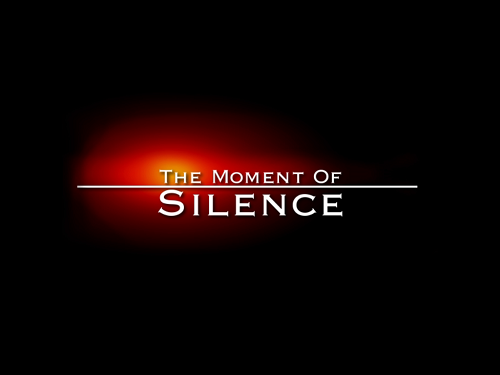 The title screen. The title screen. |
| Released: | 2004.10.01 | |
| Genre: | SciFi / Mystery | |
| Graphics: | Realistic / 2.5D | |
| Perspective: | Third person | |
| Gameplay: | Point-and-Click |
In 2044 the world has extensive network communications, driverless satcars, fast speed magtrains, oddly enough zeppelins, and space stations with centrifugal gravity that can be accessed by the space elevator. It might all be good, if it weren't for the fact that the protagonist Peter Wright is struggling on the edge of alcoholism, caused by a recent personal loss. And one day he sees through the peephole on his door how the NYPD SWAT team raids his neighbour's apartment floor, dragging away the family man who is his neighbour. All that remains is a teddy bear in the hallway and lots of questions about what just transpired in front of his eyes.
Peter Wright has a decent job as communications designer in an advertising agency of sorts, which is trying to run a campaign on issues regarding privacy, terrorism, and such serious issues. That all becomes secondary, and just means to an end, as he gets drawn into an enormous conspiracy which is shaking the boundaries of reality itself, and threatening countless of lives and the freedom of human existence.
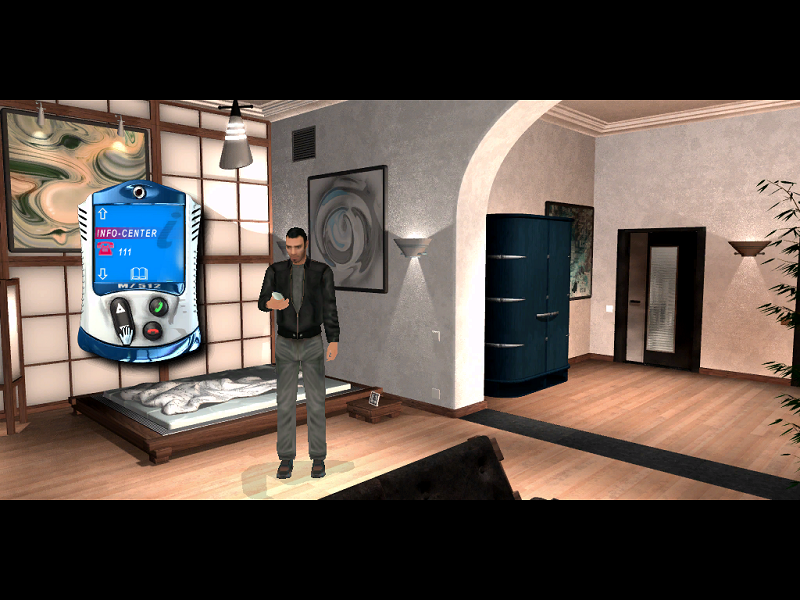 The protagonist using his messenger.
The protagonist using his messenger.
The Moment of Silence tries hard to create a picture of the near-term future that is realistic, and shows those possibilities and threats which we today recognise as possible paths for our own real future. This is a very good thing, and immediately adds to the positive sides of the game, as there aren't too many adventure games where future things are presented realistically, not that there is anything wrong with more far-fetched concepts from other games such as space portals and everything. Many of the things in the game are potentially just a step away from the current world, although giving that world such a solid year number as 2044 may be a bit too optimistic, but then again, projecting a future that is 40 years from the game release date is a generation or two into the future, which at least at the moment of release might be a good timeframe as many of the players will be seeing that year emerge one day.
The game has 3D-modelled characters adventuring against prerendered 2D backgrounds, which makes the game look good enough, at least in theory. Unfortunately there are many strange design decisions that make the game look quite odd at times. For starters, many of the locations in the game seem very still, as opposed to being dynamic. In the worst cases this means things like people in the background being frozen in the middle of stepping out of a house for the duration of the game. Developers could have at least opted to put that poor and irrelevant character to stand on the street, but as it is, that character is stepping out of the building without ever moving a pixel's worth.
According to the official statement, there are over 75 locations to explore. This is undoubtedly true simply by counting backgrounds, but there are not 75 different destinations to go to. Many destinations have several backgrounds, and the game has a very annoying and random-feel way of switching backgrounds and the angle of the camera even when it's not really needed. This makes moving the character around a very tedious task at times - it's not clear where to click, and in the worst case scenario the game totally ignores the 180 degree rule in the continuity of the movement, so sometimes it's very hard to know whether the character is moving forward, or returning to where he came from. It doesn't help at all that the path-finding algorithm in the game is bad, clearly most movement happens through some central point, so when for instance the protagonist is trying to go from left side of the screen to the right side, instead of going the fastest route possible, the character will often back to a central place, and then go to the desired location from there.
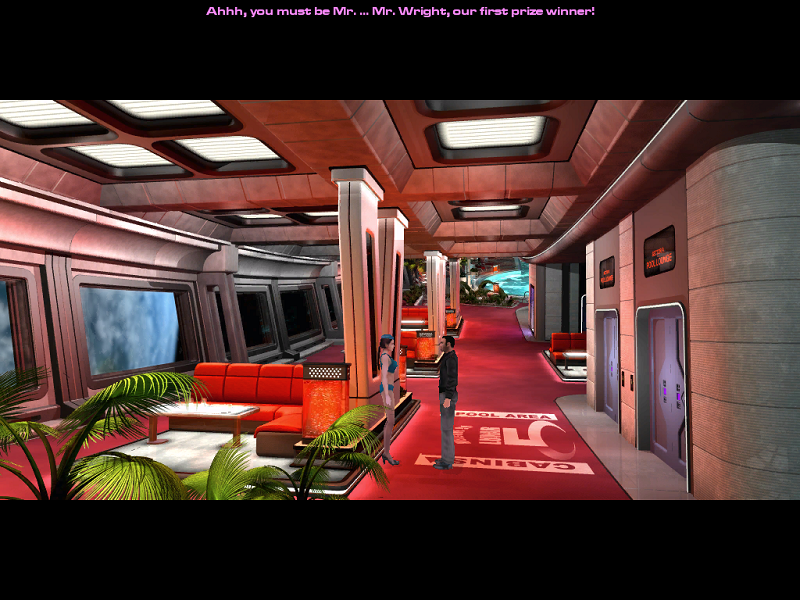 Visiting space station.
Visiting space station.
Possibly because of this, the game has an interesting two-step hotspot help button. Pressing the key "H" down for a moment will reveal all exits, and holding it a while longer will reveal all interactable hotspots. Another interesting feature is how the game tries to mimick genuine 3D at times - sometimes there is a change between two slightly different angles, and what happens between them is apparently a very short video clip, trying to show a seamless transition. It is obvious when this occurs though, as the sharpness of the image will momentarily change too, overall it's an interesting solutiong from the design point of view.
Not counting movement issues, the game is relatively straightforward to play. There are no deaths, no dead-ends, and the cursor always automatically shows either hand or magnifying glass icons over interactable objects. It is possible to view objects with right-clicking, but this seems to be an incomplete feature, as some objects don't have such descriptions. While there are no real game-breaking bugs, there are some things which give the game an alpha stage feeling of sorts. Especially this is obvious when it comes to dialogues and item descriptions. Sometimes two different characters are saying different pronunciations for the same word, sometimes there is a different tense in audio and on-screen texts (such as choose vs. chose), in some cases there is a completely different word used. And all characters in the game seem to be having a very strange pronunciation for the acronym SETI (Search for Extra-Terrestrial Intelligence), at least one never used by any real SETI spokesperson.
Speaking of which, the story has some very strange aspects to it, which are a bit annoying to any player who actually knows better. Among these are things like the game giving the impression that SETI Institute owns the Arecibo radio telescope (they don't), that SETI research is actively broadcasting a signal to outer space (it isn't), and that SETI researchers are seeing UFOs (in the real world SETI people are the most ardent UFO sceptics and debunkers). Similar problems are reflected in the in-game events. The protagonist has no problems going to the space station wearing his every day clothes, while carrying a live pigeon in his pocket, but opening a locked door somewhere can be an overwhelming task, as is the case in so many adventure games. All this requires some serious suspension of disbelief, which in most part is unnecessary, as the game could with few better design decisions stay truer to its basically more serious narrative.
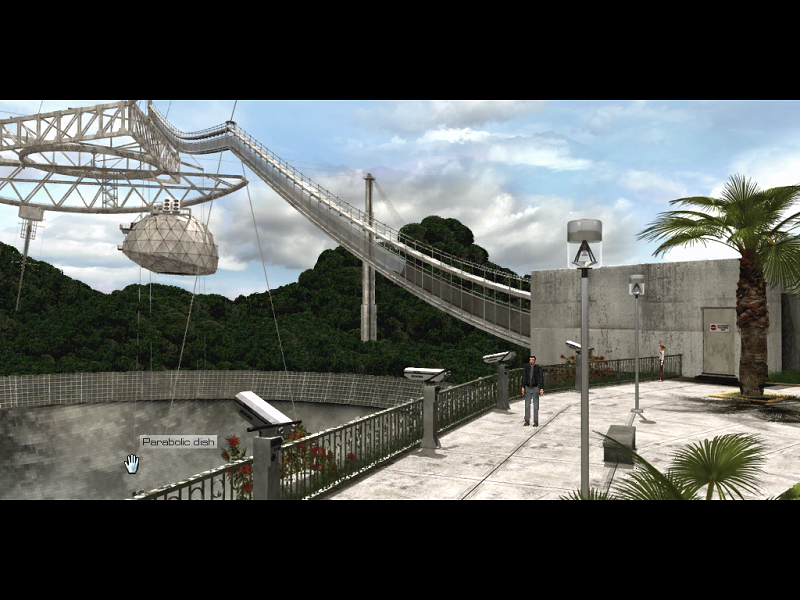 Visiting Arecibo.
Visiting Arecibo.
Logic and user-friendliness could have been better handled too. In many an occasion it is possible to start conversations about something, with no real causality that leads to that. For instance, it is possible to start a conversation about space elevators, without having any need or motive to use one, or even inquire about them. On the other hand, the game really doesn't permanently register things that have already been done. For instance, if the protagonist has identified himself with an ID scanner once to be able to pass through some doorway, he needs to repeat that every time he enters through it, which means that revisiting locations gets very repetitive with unnecessary activities.
This is one of those dialogue-heavy games where conversations go on and on. It's a good thing, and many tasks are triggered by finding right conversation choices. Unfortunately the conversation trees are not very intuitive, and it's not clear how many levels inside the tree the player is. Fortunately there is a colour-coding which shows which conversations are previously had, and which are still unexplored. Most of the actors do a very good job with their roles, with only a couple of exceptions, so while much of the playthrough time is spent on discussing with people, it always feels interesting. One minor complaint, in addition to already mentioned spelling errors, is the weird placement of the subtitles. It is not at the bottom of the screen, it is not over the characters, it is over the widescreen image area. The visible game world is in a widescreen area in the middle (although the game itself isn't widescreen), a sliding inventory is at the bottom, and the optional subtitles appear at the top. The game has also some background music, some of it diegetic, some of it non-diegetic, but mostly there is no background music, just few ambient voice effects.
There is much potential and promise to this game. It starts off very strong, feeling as if it could be one of the best adventure games ever made. It is far from perfect, however, and the further the game goes, the farther from any perfection the game drifts. Weird camera angles, logical mishaps, spelling errors, some illogical puzzles, and some unexpected pixel-huntings keep this title from becoming crème de la crème. As already stated, it feels as if it's an alpha version, waiting for the final polish. What is the strong point of the game is the story. While the ending becomes very expected halfway through the game, and the ending doesn't offer any large climax, it still feels gratifying and intriguing to see what's going on in the world of 2044, and who or what is causing all the problems that the protagonist and people around him are facing. While there are problems with the story, including plotholes that would at times allow driving an eighteen-wheeler through them, the basic premise of the story is so captivating that one is willing to ignore problems in order to see where the story is going and how things are developing.
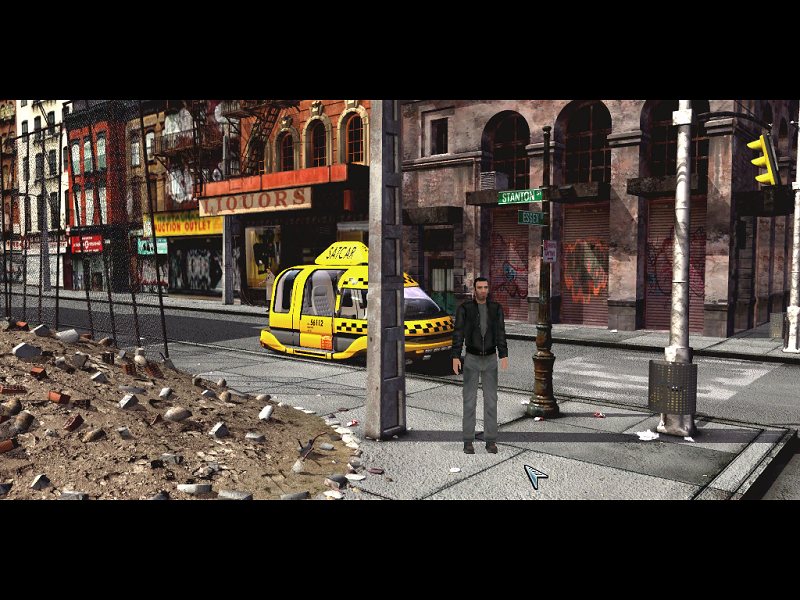 Visiting run down city areas.
Visiting run down city areas.
Developers have also incorporated some basically unnecessary, but nice little touches here and there that at least bring an occasional smile to player's face, even if the subject matter and narrative are not amusing at all. Among these little things are some in-game clocks, which actually read the time from the player's own computer, meaning that the in-game time is supposedly the same as real world time. There are things like real space shuttle landing footage on the telescreen. Examining everything closely will also reveal some witty remarks aimed at other games, such as the protagonist stating that pushing crates is a useless activity, which is most likely aimed at Broken Sword: The Sleeping Dragon, which was released less than a year before The Moment of Silence, and was heavily criticised for having an excessive amount of crate puzzles.
There are actually even two different endings to the game, one clearly being the right one, as going to the wrong one automatically returns the player to a point where the other ending can be reached. Ironically, the wrong ending would be the better one, being much more dramatic and though-provoking. Because there is much to explore, and the game being so conversation-oriented, it takes some time to finish it. An honorable mention must be given to the copywriter who came up with the first sentence in the manual: "Congratulations on buying this adventure game, which will give you thrilling entertainment for weeks to come." While "weeks" is an exaggeration for sure, the game is among the longer adventure games. After all, you get to visit the future New York, with many of its parts, space station, Arecibo radio telescope, abandoned subway systems, and freezing temperatures of Alaska. In the end it's easy to see that much effort was put into this game, and while it never reaches the potential that it has underlying somewhere, it's certainly among the best games with realistic visions of future, and as it deals with serious subject matters, it can also be seen as a commentary about the problems which the present-day society may be facing.
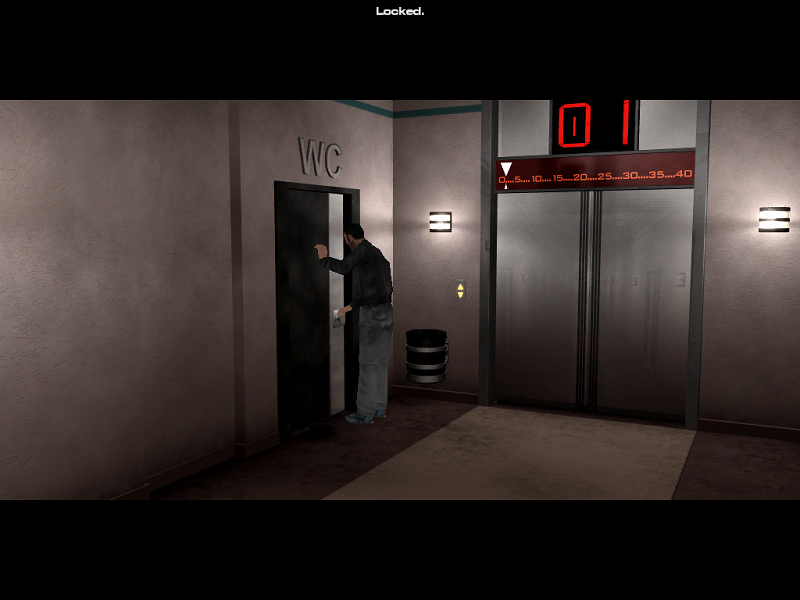 The door is locked.
The door is locked.
